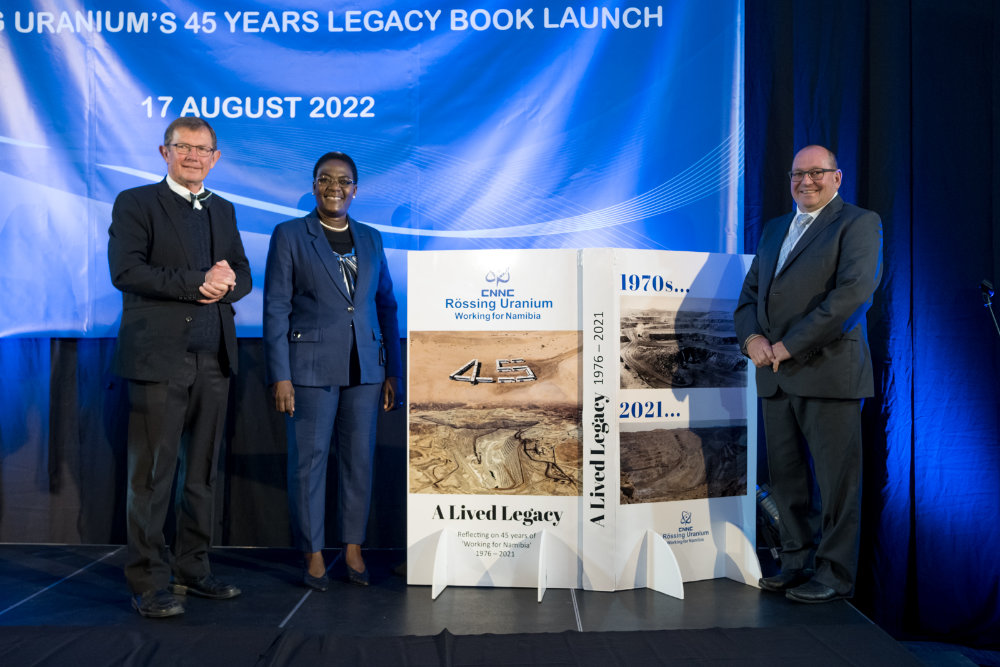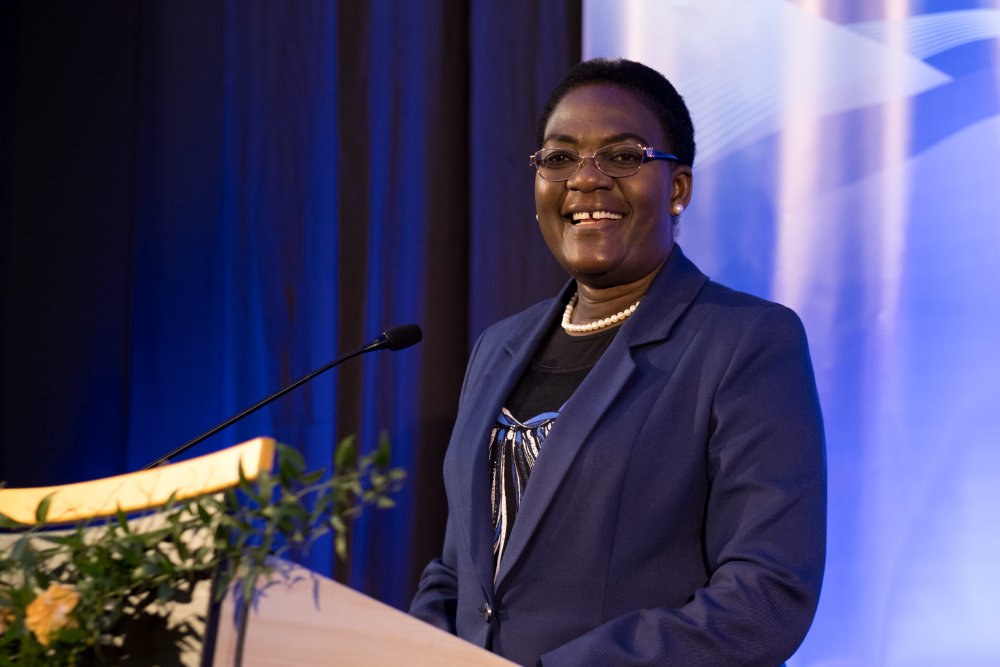On Wednesday, 17 August 2022, Rössing Uranium launched its 45 year legacy book in
Swakopmund. The 270 pages book documents the history and contributions of Rössing
Uranium’s to Namibia’s socio-economic footprint over the past 45 years (1976 -2021).
In his opening remarks: Rössing Uranium Board Chairperson, Steve Galloway mentioned how
privileged he is to be associated with Rössing Uranium and chair the Board.
“The pioneers who came before us envisioned the dream of establishing a world class,
responsible mining organisation; a Mine that would shape and guide future generations of
Namibian, mining professionals – heroes in the Namibian mining industry - who would go on to
set best practice standards not just in mining, but also in health, safety and environmental
management and corporate, social responsibility. Thousands of Namibians will attest to the
impact Rössing Uranium and the Foundation have had on their lives, including many who are
now prominent private and public sector leaders”, he said.
During her keynote address, Deputy Minister of Mines and Energy, Hon. Kornelia Shilunga
highlighted Rössing Uranium’s key developments and projects over the four and a half decades.
Hon. Shilunga also commented on the future of the Mine saying: “Life of Mine Extension is the
beacon of hope for Rössing and requires support of many stakeholders to make it a reality
starting with the recently approved Mine Licence (ML28) extension to 2036 which was granted
by our Ministry of Mines and Energy. We are looking forward to the completion of the feasibility
study toward the end of the year because the future of the mine beyond 2026 will be determined
by this outcome.”
Some of the key highlights from the book
- Rössing contributed an operating theatre to the Marie Douglas Heim in Swakopmund
which was rewired and the whole building renovated and equipped in 1980.
- On the 6th of July 1984, the Cottage Hospital (now renamed Medi Clinic and privately
owned) started functioning for all Rössing employees and dependants. The thirty-bed
hospital had infrastructure sufficient to cope with all the needs of Rössing employees.
- Rössing Uranium established the Rössing Foundation in 1978 through a Deed of Trust.
The Foundation was established as a vehicle to oversee and implement many of
Rössing Uranium’s corporate social responsibilities in Namibia. It was and is still funded
with contributions by the mine and the projects and initiatives implemented countrywide
since then to date is a legacy story on its own. The Rössing Foundation has centres in
Arandis, Swakopmund and Ondangwa offering English, science and math classes.
- As an independent gift to Namibia, in 1991 Rössing constructed the Namibia School of
Mining Technology, well known as NIMT at a cost of N$6 million. The aim of the school
was to provide Namibians with technical skills essential to the mining industry and its
support industries. The main need identified at that time was the training of artisans and
technicians’ level in the fields of engineering, mining, metallurgy, geology, survey, draughtsmanship and chemistry. NIMT continues to operate and is known to produce the most sought-after artisans to mining and other industries.
- Rössing Foundation opened a center in Lüderitz in May 1990, which was officially
inaugurated by the Founding Father and then President of Namibia, Dr Sam Nujoma
who in his speech said, “It is only right and proper that profits generated by the mines
should be used for the development of the Namibian people and I find it particularly
pleasing that a mining company has for so many years followed a policy of putting
efforts and money into developing the other two major pillars of our society, namely
fishing and agriculture.”
- The Rössing Foundation opened an Agricultural Training Centre at Okashana in
northern Namibia in 1991. The centre offered courses in animal husbandry and crop
cultivation to farmers. It also served as an experimental center at which the viability of
introducing new crops in the region could be tested. In 1996, the Foundation handed
the entire infrastructure over to the Government of Namibia, including the human
resources to continue with the activities as per the Government’s developmental goals.
Currently the Centre is run by two Ministries of Local Government, Housing, Urban and
Rural Development and the Ministry of Agriculture, Water and Land Reform.
- In 1996 the Rössing Foundation handed over to Government through the Ministry of
Fisheries and Marine Resources the Maritime Training Centre in Lüderitz. From its early
days, Health and Safety has always been a priority for Rössing Uranium, as such the
mine donated a computer and software to the Windhoek State Hospital for use by the
Head of the Oncology Department. The Oncology Clinic which had been gathering
statistics on cancer patients was not able to analyse the data prior to the donation.
- In addition to donating N$200,000 to the Ministry of Health and Social Services and
protective gear to the Swakopmund State Hospital, Rössing procured and delivered an
oxygen generating plant valued at close to N$3.8 million to the new COVID-19 isolation
facility at Walvis Bay State Hospital.
The Rössing Uranium’s book titled, “A Lived Legacy: Reflecting on 45 Years of Working for Namibia (1976-2021),” is available the Rössing Uranium Website
 |
 |
| Rössing Uranium Board Chairperson, Steve Galloway, Deputy Minister of Mines and Energy, Hon. Kornelia Shilunga and Managing Director, Johan Coetzee.jpg |
Hon Kornelia Shilunga, Deputy Minister of Mines and Energy.jpg |
Issued by:
Daylight Ekandjo
Manager: Corporate Communication
Rössing Uranium Limited
Enquiries:
Linus Kamati
Advisor: Communication
Tel: +264 520 2631
Fax: +264 520 1506
Cell: 081 45 00 678
Email: Linus.Kamati@rossing.com.na